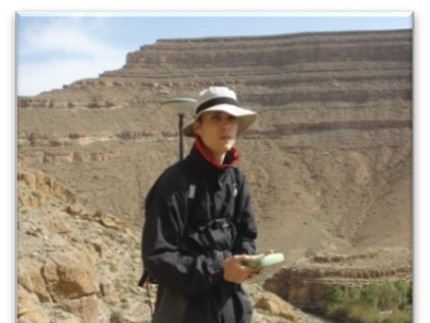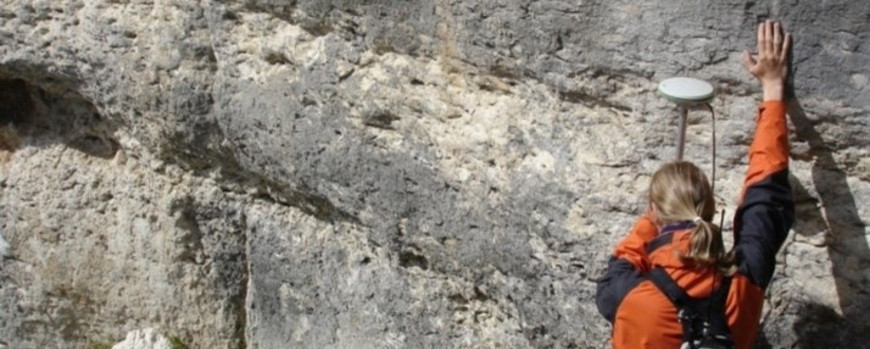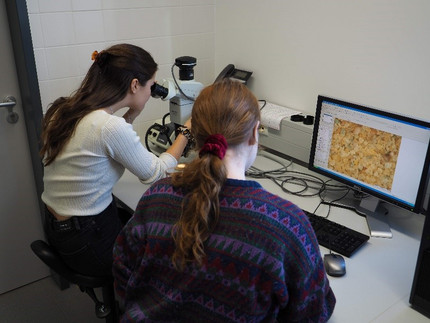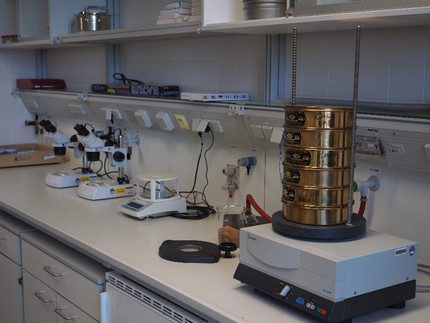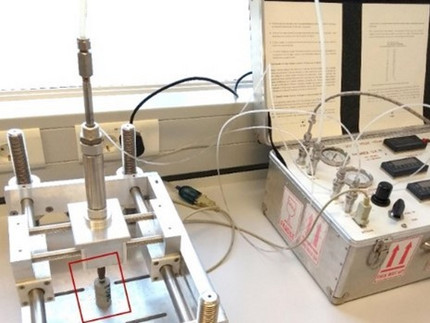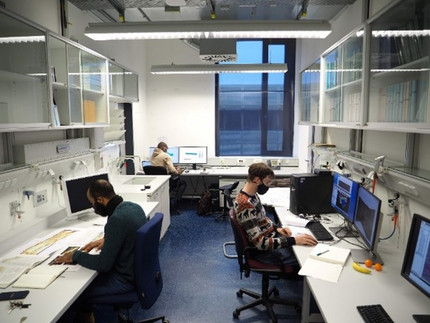Facilities
Field Equipment
We host several field devices that allow to collect 3D georeferenced data points and to image sedimentary bodies to perform quantitative and digital sedimentology (Geomodels).
- Differential Global positioning system LEICA d-GPS 1200 Serie. Equipped with two single-frequency receivers GX 1210: a rover that permits to acquire mobile and/or static points and a static base station, mounted in a tripod, that provides real-time correction data for the rover.
- Laser Locator LEICA : It measures distances and vertical angles from a specific position to the outcrop.
- Drone (with Camera)
Petrography
Petrography is a powerful tool to investigate rocks samples and loose preparates. By means of a microscope we characterize the morphology, texture and mineralogy of the components as well as to describe post-depositional features (diagenesis). This enables us to perform environmental, biostratigraphic and stable isotope analyses, as well as pore-system evolution studies. Additionally we use Digital Image Analysis to quantify sedimentary fabrics and pore space structures.
- Optical microscopes:
- Transmitted light: microscope Olympus BX 51 equipped with camera Olympus DP 72
- Reflected light: microscope Olympus SZX 9 equipped with camera Olympus XC 30
- Hand-drill system: Bravo Portable Micromotor.
- New Wave Micromill system (X-Y-Z microsampling device): Binocular microscope equipped with video/photo capabilities and carbide steel drilling mechanisms to perform high precision microscopic drilling of various lithic and biogenic materials for isotopic, trace elemental and radiometric analyses. The combination of submicron stage resolution and positional accuracy, real-time video observation and a custom designed software system allows for sampling of complex structures in skeletal and crystalline materials.
Sediment Processing
The sediment processing laboratory is a space for preparing marine and non-marine sedimentary samples for microscopy and other analyses, which require individual components or fabric specific analysis (e.g., Mass Spectrometry, trace metals, isotope studies…). Preparation methods include separating and picking of biogenic particles, thin section dying techniques, sieving for granulometry, and creating smear slides and acetate peels.
- Retsch Siever AS200 (Rotating shaker) of different grain size and Retsch Test Sievers
- Ultrasonic cleaner (Retsch UR3, Bandelin sonorex super RK100SH)
- High-precision balances (up to 0.1 mg) (Kern ABS, AND FX-200i)
- Humidity Free Chamber for sample storage
- Shaker
- Drying oven and heat plate
- Staining with Alizarin Red S and potassium ferrocyanide
Petrophysics
In our petrophysics lab, we aim to unravel the complicated relationship between porosity and permeability in sedimentary rocks, reconstruct the origin and modification of the analyzed pore system throughout its paragenetic evolution, and precisely detect small-scale heterogeneities of petrophysical properties. Such detailed and comprehensive pore system analysis does not only complement to the understanding of the depositional and diagenetic rock-forming processes, but is of absolute essence for subsequent reservoir characterization studies and economical assessments in the field of hydrocarbon, geothermal or hydrological (subsurface) exploration.
- Manual Gas Permeameter/Porosimeter MG2P (Sanchez Technologies):In order to measure total porosity and permeability simultaneously on the same sample plug, which ensures that both parameters can be directly linked, we use the. We measure steady state, Klinkenberg and Pulse Decay permeability as well as porosity (pore volume) and grain volume under ambient conditions through helium injection.
- Digital Probe Permeameter (Corex): In order to detect inhomogeneities of permeability within rock cores, slabs or plugs, we further use the, which allows for measuring nitrogen-injection probe permeability at several spots with a radius of 1 cm along a 2D transect or within an 3D area, yielding permeability profiles or maps of the specimen.
- AccuPyc 1330 and GeoPyc 1360 (Micromeritics ): Solid density, solid volume and pore volume of cylindrical plugs or loose sediment samples are further measured with helium-injection by combining the AccuPyc 1330 (for absolute density) and the GeoPyc 1360 (for envelope density)
Sedimentary systems Modelling
The sedimentary systems modelling lab is where we process all our collected data. Here, we use numerical methods to evaluate and combine multidisciplinary data at different scales. These can be data from the field, such as georeferenced sections, LIDAR scans, or from the subsurface, such seismic and well data.
The aims are on one hand to produce 3D geological models for stratigraphic architecture and facies distributions. On the other hand we use forward stratigraphic models to test fundamental concepts and research hypotheses.

